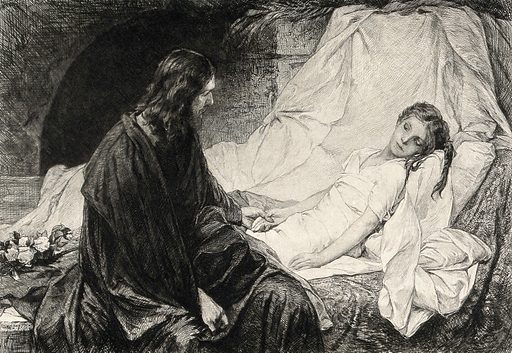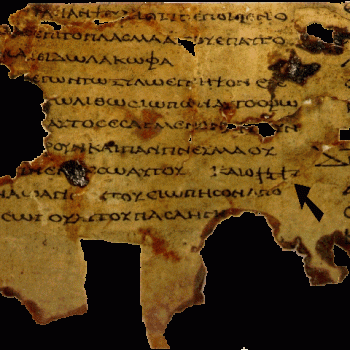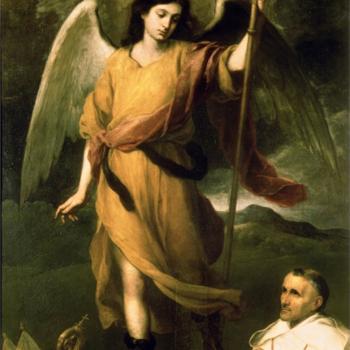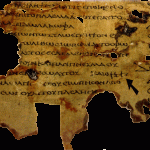
Atheist anti-theist Jonathan M. S. Pearce is the main writer on the blog, A Tippling Philosopher. His “About” page states: “Pearce is a philosopher, author, blogger, public speaker and teacher from Hampshire in the UK. He specialises in philosophy of religion, but likes to turn his hand to science, psychology, politics and anything involved in investigating reality.”
This particular post was written by guest contributor David Austin. But since Pearce clearly endorses its contents, I’ll include it as #44 of his never-ending potshots against the Bible and Christianity. Austin’s words will be in blue.
*****
Mark 5:22-23, 35-36 (RSV) Then came one of the rulers of the synagogue, Ja’irus by name; and seeing him, he fell at his feet, [23] and besought him, saying, “My little daughter is at the point of death. Come and lay your hands on her, so that she may be made well, and live.” . . . [35] While he was still speaking, there came from the ruler’s house some who said, “Your daughter is dead. Why trouble the Teacher any further?” [36] But ignoring what they said, Jesus said to the ruler of the synagogue, “Do not fear, only believe.”
Luke 8:41-42, 49-50 And there came a man named Ja’irus, who was a ruler of the synagogue; and falling at Jesus’ feet he besought him to come to his house, [42] for he had an only daughter, about twelve years of age, and she was dying. . . . [49] While he was still speaking, a man from the ruler’s house came and said, “Your daughter is dead; do not trouble the Teacher any more.” [50] But Jesus on hearing this answered him, “Do not fear; only believe, and she shall be well.”
Matthew 9:18 While he was thus speaking to them, behold, a ruler came in and knelt before him, saying, “My daughter has just died; but come and lay your hand on her, and she will live.”
It is note-worthy, that Mark’s account says “My little daughter is dying” contrasting with Matthew’s account which says “My daughter has just died”. So which is it, was Jairus’s daughter dead or dying when Jairus first approached Jesus? You may think this is a trivial matter, but both statements cannot be correct; there is a contradiction.
This is rather simple to solve. It’s untrue that every Gospel “must” give every detail of every incident or someone’s words. According to whom? Where is this “requirement” written in stone? As in real life, people report different things; some highlight or concentrate exclusively on one element, another does differently.
This factor alone explains away perhaps 40% of all of atheists’ alleged biblical “contradictions”. I know, because I’ve dealt with scores and scores of them, myself, and this silliness and logical foolishness is a constant theme. They momentarily lose comprehension of — in their zeal to mock and deride the Bible — the fairly simple laws of logic.
The solution of the supposed conundrum is in the texts themselves. Austin cited Mark at length (including 5:35) and noted that “Luke’s account is substantially the same.” Note what occurs in the two parallel accounts of Mark and Luke:
1) Jairus approaches Jesus and says, “My little daughter is at the point of death” (Mk 5:23); Luke (as narrator) reports that “she was dying.”
2) [Seemingly] immediately afterwards in both accounts (Mk 5:24-34; Lk 8:43-48), Jesus heals the woman who had a “hemorrhage” (Mk 5:29) or “flow of blood” (Lk 8:43).
3) Then a man from Jairus’ house comes and reports that his daughter is “dead” (Mk 5:35; Lk 8:49).
4) Thus, there is a gap between the time when Jairus’ a) knew his daughter was dying, until the time that b) reports came that she had indeed died.
Matthew, possibly — but not necessarily — using the well-known and established literary technique of compression (which I have addressed elsewhere: including reference to this incident), simply records 4b (his daughter’s death) rather than 4a (his despair in knowing his daughter was dying, and his seeking a healing from Jesus). Matthew uses about 176 words in writing about this event, whereas Mark utilizes around 481 words (2.7 times more than Matthew).
It’s not a contradiction. We know from Mark and Luke that he learned of her death while he was still pleading with Jesus to heal her. So where is the problem here? There is none, for anyone who looks fairly at the texts and employs simple common sense.
Note that Matthew also includes a section (9:20-22) on the woman with a “hemorrhage” (9:20). It’s a different chronology or order than in the other two accounts, but this is completely normal in 1st century Jewish writing, since that culture had a different conception of chronology than we do today.
See, for example, Jacques Doukhan’s book, Hebrew for Theologians: A Textbook for the Study of Biblical Hebrew in Relation to Hebrew Thinking (University Press of America, 1993). He noted that in the Hebrew mind, “the content of time prevails over chronology. Events which are distant in time can, if their content is similar, be regarded as simultaneous.” (p. 206)
Likewise, Thorleif Boman, in his book, Hebrew Thought Compared with Greek (New York: W. W. Norton & Company, 1960), devotes 61 pages to the topic of “Time and Space.” He explained that for the Hebrews, “time is determined by its content, and since light is authoritative and decisive, the light was called day and the darkness night even before the creation of the heavenly luminaries (Gen. 1.5).” (p. 131)
He observed also:
[W]e, too, characterize time by its content. We speak of wartime, peacetime, hard times, time of mourning, feast time, favourable time, office hours, bad year, etc. . . .
Thus, in part, the chronological times were named and characterized in accordance with their content in the Old Testament; day is the time of light and night is darkness (Gen. 1.5; Ps. 104.20). (p. 140)
Mark devotes ten verses to the same incident of the woman with a hemorrhage (5:24-34), or 3.3 times more than Matthew does, and Luke provides six verses to it (8:43-48), or twice as many as Matthew. Thus, this supports the belief that Matthew is again (?) employing compression (as he is thought by many commentators to habitually do).
All three accounts, however, have Jairus — and Jesus — being aware of his daughter’s death (Mt 9:18; Mk 5:35; Lk 8:49), before Jesus goes to heal her (Mt 9:23; Mk 5:37-38; Lk 8:50-51).
Problem entirely solved! Matthew merely didn’t mention the part where Jairus told Jesus that his daughter was dying. He gets right to the point and has him telling Jesus (after being informed by a person of his house) that she was already dead (just as Mark and Luke also report the fact of her death). Then Jesus goes (after that report) to heal her, in all three accounts.
After becoming aware of all this, only a person relentlessly, irrationally, and obstinately hostile to the Bible and/or Christianity could possibly still think a “contradiction” was present.
***
Photo credit: Jesus and Jairus’ Daughter; etching after Gabriel Cornelius von Max (1840–1915) [Look and Learn / Creative Commons Attribution (CC BY 4.0) license]
***
Summary: Jonathan MS Pearce (by endorsing a guest writer) believes that a contradiction exists in the report in three Gospels of Jesus raising Jairus’ daughter from the dead. He’s wrong, as usual.













